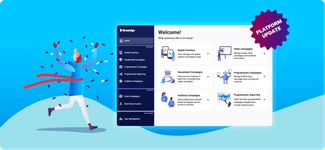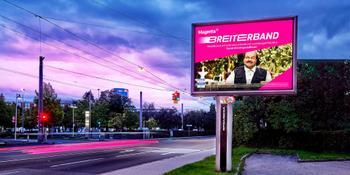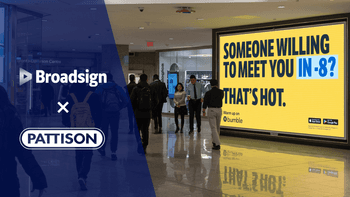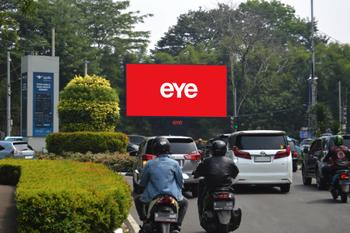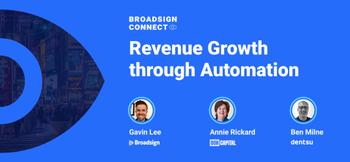When looking at the different ways DOOH inventory is sold today, the two primary ways are through direct sales and programmatic digital out-of-home. We often compare them, trying to decide which is the best method to sell DOOH inventory. However, the reality is that many media owners sell both directly and programmatically, as it helps them optimize their inventory.
While directly sold campaigns are generally long-term commitments with fixed start and end dates, programmatic campaigns are more flexible, allowing you to slot them in when there’s availability. In essence, programmatic campaigns can be used to help fill the remaining space not taken up by fixed campaigns.
Generally, a media owner would allocate 80% of their inventory to direct sales and 20% to programmatic. Now, let’s say that for one month, 70% of your inventory is accounted for through direct deals and 10% through programmatic; you now have 20% of your inventory that is not accounted for. Traditionally, filler content, like the time or weather conditions, would play on the screen when there are no scheduled campaigns, but what if you could turn that 20% into additional revenue?
Many media owners, including our own customers, are now turning to ad servers as a third selling channel to help them transform their filler space into additional revenue. Capable of delivering campaigns dynamically with the use of audience and contextual triggers, Broadsign’s ad server – known as Audience Campaigns in the Broadsign Platform – plays alongside your direct and programmatic campaigns, maximizing fill rates and generating new revenue for you. Below, we highlight a few examples of how our customers are using Broadsign Audience Campaigns to unlock new opportunities and additional revenue.
Sell premium, data-triggered audience campaigns
The primary way our customers have been using Broadsign Audience Campaigns is to sell premium audience-based campaigns. With access to anonymized aggregated data that allows you to target specific audience segments based on audience demographics, buying patterns or points of interest, advertisers can easily reach prospective buyers.
Plus, with ads dynamically served based on contextual triggers, like weather or financial moments, ads will only be seen at the ideal time and place. While these data triggers are offered at a premium price, advertisers are willing to pay for it as it helps them spend their ad dollars more effectively by reaching the intended audience where they’re more likely to be found in large numbers.
For instance, an agency needs to launch a campaign to promote a new sports shoe for a global shoe brand. With the ability to target audiences by gender and age group, as well as target ideal environments, like gyms or shopping malls, the agency can easily reach the brand’s on-the-go customers and show the ad when it’s most contextually relevant.
Another example is a large coffeehouse company that is launching its limited-edition winter drinks for the holiday and wants to target daily commuters on their way to work. With Audience Campaigns, the coffeehouse company can leverage screens across the city’s transit system to dynamically deliver ads during the weekday at peak transit times in the morning and evening when the weather is below -10°C.
Widen your customer base by accommodating budgets of all sizes
Another advantage our media owners saw when using Broadsign Audience Campaigns was that it made smaller campaigns from local advertisers and small agencies more profitable. Traditionally, most networks require a minimum spend or campaign duration, making it difficult for local advertisers who don’t have the budget to meet the required commitments to advertise with OOH.
To address this problem, one of our customers ran small-budget campaigns through Audience Campaigns. Given that the campaign would run as an impression-based campaign, the media owner could play the local advertiser’s ad only when there is availability, as the campaign’s only requirements are to hit a target number of impressions and remain within budget. While advertisers still had to pay a premium CPM as they were buying in smaller volumes, they were willing to do so for a shorter, more flexible campaign.
Transitioning local campaigns to Audience Campaigns created more availability for long-term guaranteed campaigns booked by larger advertisers, as smaller campaigns were no longer taking up space in the loop. It also reduced the administrative workload for the media owner’s sales team. Setting up small campaigns, which previously required the sales team to be more hands-on, would now take a matter of minutes from proposal to deployment.
Curious as to how easy it is to set up a campaign in Audience Campaigns? Here’s our senior product manager, Maxime Deleris, with a quick demo:
Monetize filler, unsold or skipped slots
Another advantage of being able to activate campaigns in a matter of minutes instead of days is that you can use Broadsign Audience Campaigns to book last-minute deals without causing additional stress on your operations team. In fact, one of our customers was able to monetize their unsold slots, which would usually have been filler content, by selling them as last-minute ad server campaigns.
Traditionally, unsold slots are sold at deep discounts to encourage last-minute deals with advertisers. However, the media owner noticed that several advertisers with last-minute campaigns were willing to pay a premium if it meant that they could secure a spot. Additionally, since setting up a last-minute ad server campaign took significantly less time than a direct-sold campaign, the media owner decided to book all last-minute deals in Audience Campaigns.
As Audience Campaigns prioritizes CPMs over first-come, first-served, advertisers are encouraged to pay more for the spot, generating the media owner significantly more revenue than if they had sold all deep-discounted slots. Since switching to this revenue strategy, the media owner now has a pool of over 60 advertisers willing to pay a premium for unsold inventory whenever it becomes available, completely eliminating the need to sell inventory at deep discounts.
Furthermore, moving all last-minute deals into Audience Campaigns not only gave the media owner more inventory to sell as guaranteed campaigns but also helped increase guaranteed campaign bookings. Advertisers looking to book last-minute guaranteed campaigns could no longer do so, forcing them to book their guaranteed campaigns earlier.
Ensure you’re hitting campaign objectives with real-time reporting
The measurement and reporting of a campaign’s performance is arguably the most important step of an ad campaign. It allows you to see what worked and, most importantly, what didn’t, ensuring that ad dollars are being used effectively to meet business goals. Broadsign Audience Campaigns provides you with real-time data to make quick changes to ongoing campaigns. With access to post-campaign reports, you can give buyers better visibility on their campaign performance, enabling them to adjust their strategies.
Here’s Maxime again with another demo on just how granular or broad you can go with our real-time reporting:
With Audience Campaigns made available as part of the Broadsign Platform, you can sell guaranteed, programmatic and audience campaigns all in one place. Acting as modules with a unified notion of users and inventory means you can switch between our solutions seamlessly, allowing you to incorporate as much of the different sales channels as you want.


